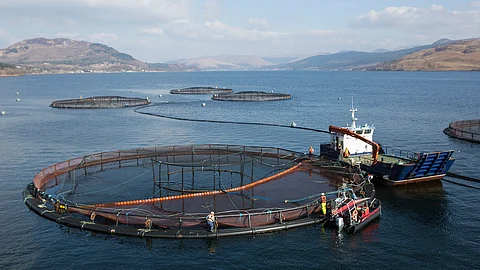“Finding a vaccine-based solution for treating sea lice would be a huge development for the aquaculture sector globally, with widespread impact for fish, farmers, the supply chain and consumers," says lead researcher, Dr Sean Monaghan.
Photo: SAIC.
Groundbreaking sea lice vaccine research progresses to next stage
It's one of the biggest challenges facing the salmon aquaculture sector: the perennial problem of sea lice.
Each year, protecting, managing and treating salmon affected by sea lice costs the global industry an estimated $1 billion per year - and some of the current approaches are far from ideal in terms of fish health and welfare, as we have seen from recent industry news.
In this context, finding a vaccine for sea lice may seem like the aquaculture version of discovering the holy grail.
But that's precisely what a team of Scotland-based researchers are working on - and after a successful proof-of-concept last year, they are now taking their research to the next stage.
Incorporating expert partners from the University of Stirling's Institute of Aquaculture, AQUATRECK Animal Health SL and Moredun Scientific, the research project has previously secured £1.5M funding in UK research council funding, and has now been awarded additional funding of almost £50,000 from the Sustainable Aquaculture Innovation Centre (SAIC).
Oral vaccine could be scaled up for use in salmon feeds
The researchers are now working on assessing the impact of the novel vaccine technology against adult lice, building on the results of initial research which looked at larval stages and identified a salmon gut protein required for protection.
The team is using advanced recombinant expression technology for injection vaccination, which they say could be scaled up to make mass antigens available for use in salmon feeds as an oral vaccine.
According to the researchers, the vaccine formula has been "specially developed to trigger an immune response and create elevated antibody levels in the bloodstream of fish, helping to impair sea lice development and reproductive capacity following sea lice feeding on the fish".
By targeting mature lice, the vaccine could also reduce the number of parasite offspring, the researchers say.
Worldwide interest in sea lice vaccine development
Lead researcher Dr Sean Monaghan, who is also lecturer at the University of Stirling's Institute of Aquaculture, said that a vaccine-based solution for treating sea lice would be a "huge development" for the industry, with a positive impact on the entire value chain.
"We are hoping that this second stage of the project will demonstrate the efficacy of the vaccine for protecting Atlantic salmon against adult lice and help to build the scientific evidence base," Monaghan explained in a press release.
“The Covid era has had a big part to play in increasing people’s understanding and changing perceptions of vaccines to the point where this kind of treatment for animals is now more widely acknowledged as a positive way to tackle health challenges with less intervention."
"Around the world, different groups including both academics and pharmaceutical companies are now looking at the potential for sea lice vaccines with results beginning to emerge. Sea lice vaccination is just one option, but it has the potential to transform the way the sector deals with one of its biggest ecological concerns," Monaghan added.
Benefits for fish health and welfare
An oral vaccine for sea lice also has the potential to significantly improve fish health and welfare, said Heather Jones, CEO of SAIC.
“After a highly promising first stage, it is great to see this research progressing because of a successful collaboration between sector experts and researchers. An alternative treatment for sea lice would have significant, positive outcomes for fish health and welfare, which is a priority area for SAIC," Jones said.
"Projects like this, which demonstrate innovation in finfish health, are crucial to creating a more environmentally friendly and economically impactful future for the sector," she added.


